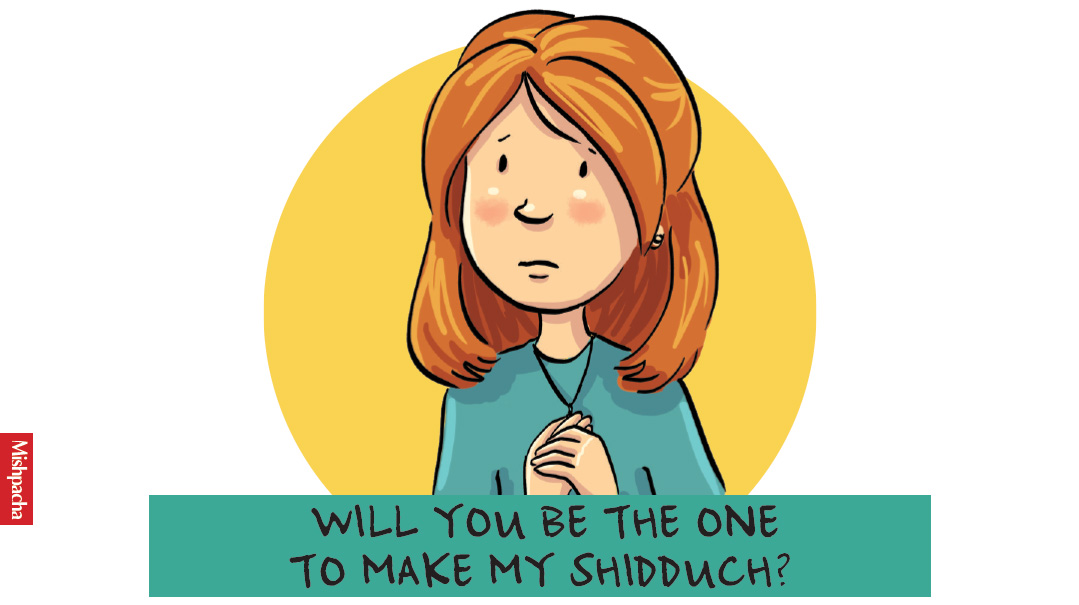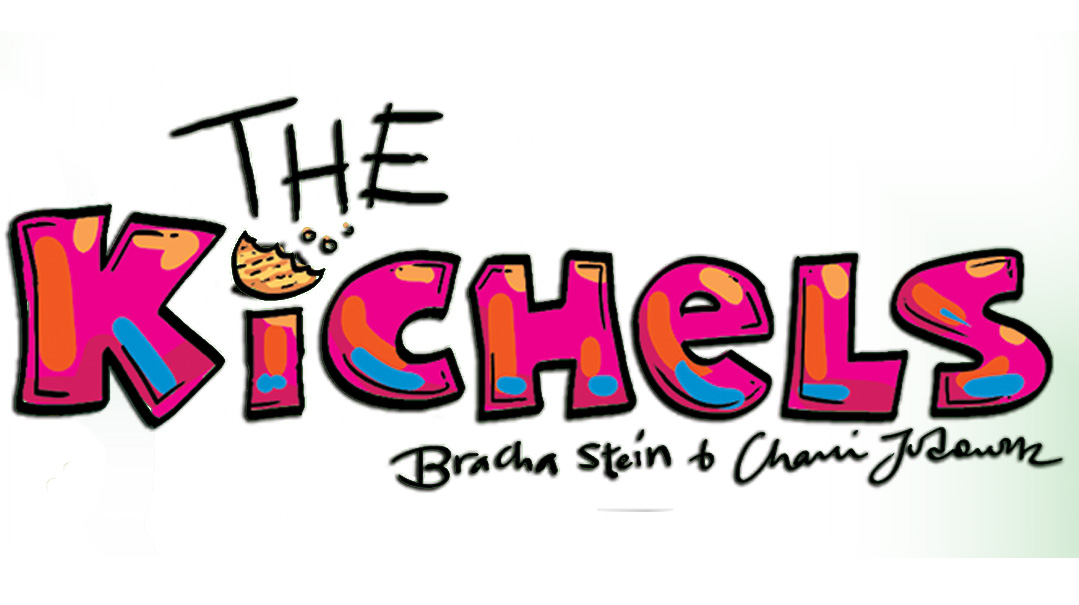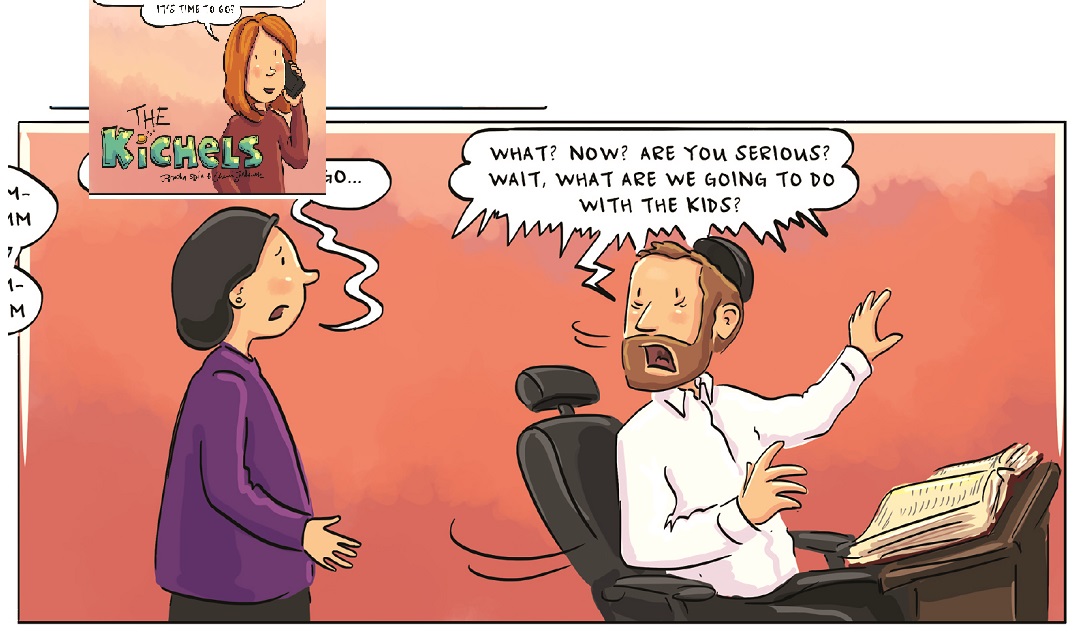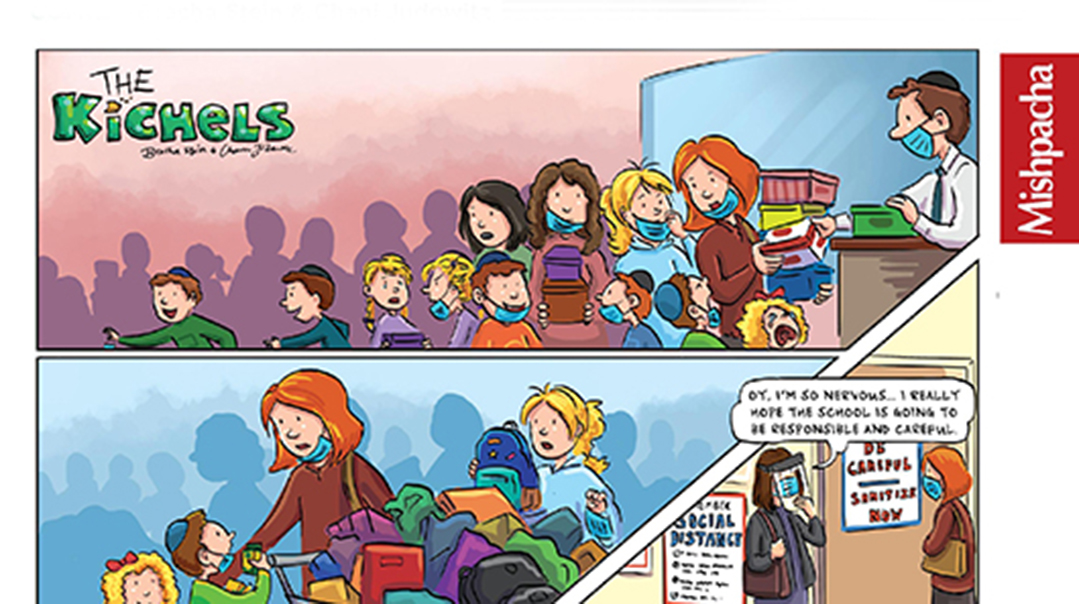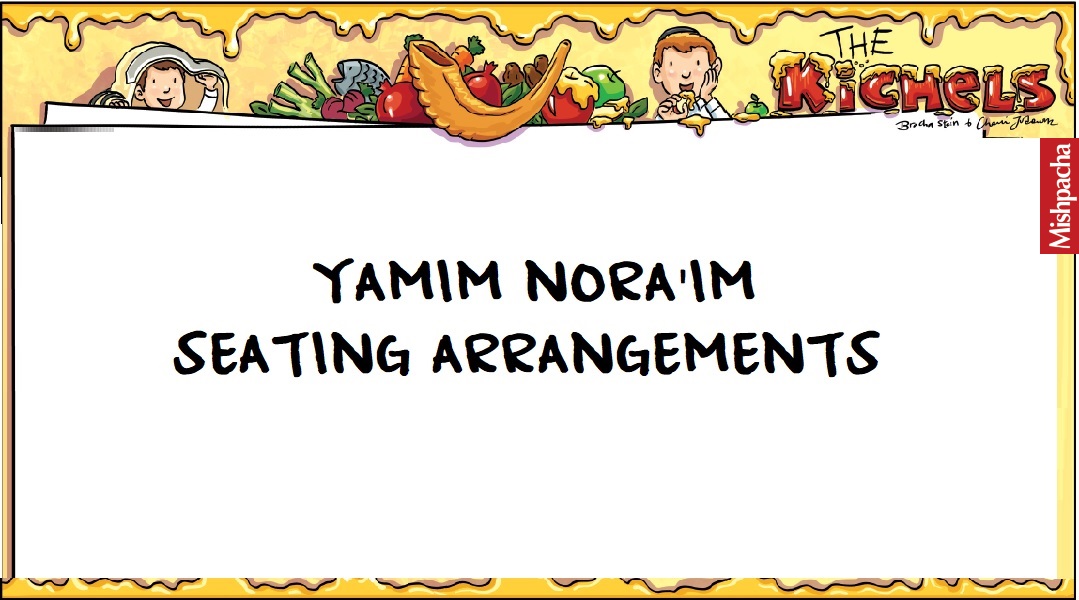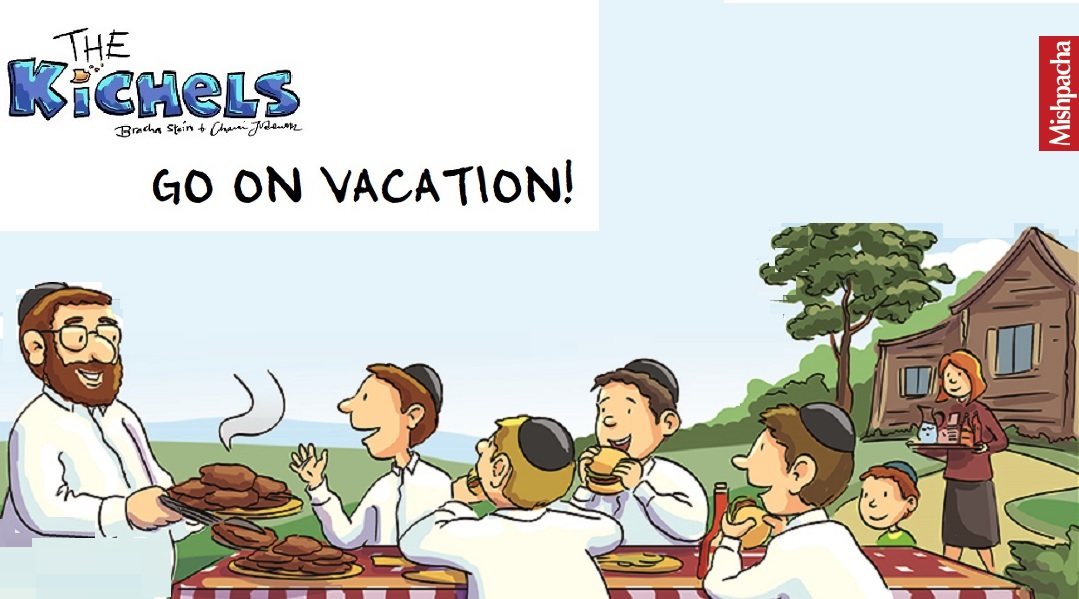Behind the scenes with the kichels

The Kichels started as a half-baked idea that met with a lot of skepticism.
A full-page comic serial? For adults? But over the course of the past two years, it’s become clear that the idea is a recipe for success. There’s something about the Kichels’ combination of dry humor with frum-specific foibles that’s succeeded in winning readers’ hearts and offering endless opportunities for gluten-related wordplay in a way no trendy pastry ever could.
Here, readers share their thoughts and impressions of the Kichels — and Bracha and Chani give us a behind-the-scenes peek into the making of the Kichels
Behind the scenes with BRACHA
Coming up with ideas for the Kichels takes longer than you’d think, as I alternately scribble, brainstorm, and frantically comb through my Gmail drafts. Finally, I’ll email Shana Friedman, Mishpacha’s managing editor, with a few ideas. If I’m lucky, she’ll approve one of them. Then I start drafting and researching. Oh, and harassing friends and anyone with the misfortune of being related to me, asking them to, say, help me come up enough ideas to make a passive-aggressive Chanukah gift guide. (Spoiler alert: they didn’t. Thanks for nothing, harassees.)
So most ideas take work. But occasionally, one will swoosh into my inbox or waft my brain, like manna from heaven... or maybe plop down like a banana whose duct tape adhesive has loosened.
Some jokes write themselves. As soon as I read the saga of the art installment Comedian I knew we had to Kichel it. In brief: a banana duct taped to the wall was declared art and sold — three times! — for $120,000 and up. Then a performance artist ate it, but luckily, the gallery explained that the buyers hadn’t lost their money, since they’d actually purchased the concept behind the artwork, not the banana itself. Let me be clear, though, that I’m not making fun of the artist. I mean, he figured out how to make $390,000 selling a banana! The concept of a banana.
Shana gave me an immediate green light.
Then I got to work, spending hours of contemplative thought selecting the household items most likely to be portents of meaning. Just kidding. I spent 45 seconds deciding what to feature, and 30 of those were spent consulting my 12-year-old son. The writing did take more time, but it was a lot of fun.
Then it was time to send this wending out into the world — er, Chani’s inbox. I wasn’t sure how to best portray this in a comic — but luckily, that’s not my problem.
Humor can be tricky, and there’s often a fine line between a good joke and leitzanus. Mishpacha’s rabbinical board approves all of the Kichels before they go to print, beginning with the script. They’ll also review the final drawing when it’s ready.
Behind the scenes with CHANI
When I get the script, I read it through and then start generating ideas for how we could lay it out. I take into account the number of characters, the setting, the time-flow: Is the dialogue sequential? Or do we have one scene in which everything takes place at the exact same moment? The most important thing, of course, is that the comic’s flow should be clear and that the illustration serves the text well.
Sometimes it’s simple: when there’s continuous dialogue between a few characters in a similar setting. When this is the case, I’ll usually use the classic setup, with four rows of strips divided into panels. Other times, when the script consists of one big scene, I’ll create the comic within one large box. I try to keep the layouts somewhat different each time so that the strip seems exciting.
In this specific case, the script seemed more abstract (no pun intended) to me. I wasn’t sure how to incorporate all of the “art” described in the script into one big scene. The obvious solution was to just place each one in its own frame, so we’d have five pieces of artwork displayed on the page, with no people, just text. But that seemed a bit boring.
I wanted to figure out if there was any way to make the scene more dynamic… so I started sketching.
I tried out a few different options — a bedroom? A kitchen? — but nixed them all. (It would be unlikely to find a sheitel head and spaghetti in the same room.) I decided to create the scene in a room that would look like an art gallery.
Next, I had to figure out the perspective of the room. Would we be seeing the room from an angle straight ahead of us, as though we were standing in the room? Or from above? Below? After trying a few sketches, I saw that the only angle that would work was from above. That was the only way readers could see all the different frames in a way that distributes the frames along the page nicely and clearly.
Once I had the perspective figured out, I copied and pasted the text from the script into Photoshop. I moved the text around to figure out the best placement. After that I sketched each individual picture frame and the people around it.
As I was sketching the people — I tried to figure out how each Kichel character could best interact with the piece of art, using inspiration from the ideas that Bracha included in the script along with some of my own ideas.
Once the sketch was done, I sent it to Shana and Bracha for approval. As you can see, it’s a pretty rough sketch — but it gives the basic idea of the layout and concept.
STEP BY STEP WITH the kichels
Step 1: SKETCH
I think it’d be a great idea to give each piece a title, like real artwork in a museum would have. I put in one example, then email Shana and Bracha to suggest it.
Chani
Hmmm. Chani drew Chanala standing near the vase, but I’d wanted to have Chesky be the guilty party — the text shows him blaming someone else. I e-mail Chani and ask if we can switch around Chanala with Chesky.
Bracha
Note the missing apostrophes. That’s because the font we use doesn’t come with apostrophes — I’ll add them in separately, using a different font, at a later stage.
Chani
I really wanted this comic to give a hat tip to its inspiration, but the text I tried writing to give some backstory just felt forced and heavy-handed. Then a friend, Rivkah Lewis, came up with the genius solution that we just insert a duct-taped banana into the illustration. Done!
Bracha
Once the sketch is approved, I move onto the linework phase. Here I define the drawing by going over the sketch (which is on another layer in Photoshop with reduced opacity) with clear inked lines.
After completing the linework, I send it again to Shana and Bracha for approval.
Chani
Shana will frequently weigh in at this stage to help us make sure it’s all coming together. Is the punchline sharp enough? Is the dialogue natural? Sometimes the clothing needs to be tweaked — for example, a character may need to put on or take off his hat and tie, depending on the setting.
Bracha
I try to take a close look at this. It’s so time-consuming for Chani to make changes to illustrations, so we try not to do that after the sketch stage. Sometimes, though, there’ll be details in the linework that we want to tweak, like a character’s expression — maybe I’d envisioned them as mad while Chani had them looking exasperated. Here, everything looks great!
Bracha
Step 3: FLAT COLOR
Time for my favorite part: Coloring! I start coloring by blocking color into each section of the illustration. First, I put in a background color (here, the floor and walls). Then I put in the color for the larger parts of the illustration (e.g., the furniture), and then I color the people.
Chani
Step 4: COLOR WITH DETAILS 1
Once the illustration is completely filled in with the solid colors, I start adding details. Here, for example, I put in the wooden floor and some of the cast shadows — these already make the illustration pop much more.
Chani
Step 5: COLOR WITH DETAILS 2
Chani reminds me that we’re adding museum placards with titles and medium used. I suggest she help me with the medium, since she’s the artist here. Together, with a little help from Google translate, we come up with titles and descriptions that are sufficiently pretentious to delight us both.
Bracha
I continue to add in details — different types of shading, different textures, and lots of lighting effects to give the illustration depth. This takes a while, but it’s a lot of fun. I can usually listen to music, a shiur, or a podcast while doing this. Once everything’s colored in, I usually add a few adjustment layers in Photoshop to make the colors more saturated.
Once the coloring is finished, I e-mail one last time to Shana and Bracha for any last minute changes. Here is where we added in the museum placards with the titles and made a couple of small text edits.
Chani
Step 6: FINAL
As always, getting the finished product in my inbox is just so much fun. This is one of those strips where the end product looks completely different from how I’d initially imagined it — and so, so much better! I’m so excited to send this to print.
And look, I don’t want to brag or anything, but Maurizio Cattelan spent over a year working on his artwork. We pulled this off in under three days.
Chani
Readers interested in purchasing the concept behind this artwork for obscene sums of money are invited to contact us at any time. For the right price, we’ll even come to your door to personally duct-tape it to your wall.
The kichels and you
We asked you where you’d seen Kichel crumbs in your life…and the responses poured in. Here, a sampling of the 100+ emails, poems, photos, and even knock-off Kichel comics that we received.
It was with terror in my heart that I came to the realization that Rochi Kichel has been in shidduchim for two full years already! I understand that her options are somewhat more limited than her older sister, what with her having no yichus to speak of, but could you really not conjure up any cartoon shidduch for her?
Her parents, although somewhat frazzled and not what I would term balebatish (Mrs. Kichel basically lives in her snood and I can tell that Rabbi Kichel’s shirts are of the non-iron variety), seem to be great parents and erliche Yidden. I for one would probably not do a shidduch with them (for reasons other than my oldest son being four years old), though I’m sure there are many who would.
Let us put an end to the shidduch crisis for poor Rochi Kichel already and see her to the chuppah.
Estelle Mann
P.S. I look forward to seeing the mother-in-law cartoons that will follow Rochi’s marriage.
Last year, you ran a very funny Kichels about dressing our children in the newest season’s clothing, despite the actual temperature. Last year’s style was the wool outfits with faux fur trim. Because it was a leap year, Succos fell out very early, and on Simchas Torah, the temperature was in the eighties.
A former student of mine walked into shul with her kids, all wearing the wool and faux fur outfits. I couldn’t help but smile. She smiled back and said, “We are the Kichels!”
Shari Weiss
Kew Gardens Hills, NY
Ever since that comic strip where newly married young Mr. Kichel keeps getting himself into trouble for being a bochur, my husband has officially added a new line into our shalom bayis dictionary: “pulling a Kichel.” He’d say that whenever he knew I wasn’t happy with something he did, but he had no idea what he did wrong.
I’m not an inbox writer (it’s a type). But I am an avid Kichels (litvishe) chassid. It’s the first thing I look at when I open the Mishpacha magazine Friday night. I’m the mother of a large family, ranging in age from 18 down to infant, have a playgroup in the house, and my husband’s a rebbe. The Kichels are us… or maybe we are the Kichels?
This past summer we took our kids on a less-than-two-hour car trip to a get-away home with my parents and siblings. While we knew the car ride wouldn’t be easy, we figured, after 12-hour flights to the US, this wouldn’t be such a big deal. The entire ride there was a nightmare — usually calm baby turned into a screaming baby, carsick child throwing up, another child thrashing, crying, and screaming from sheer boredom, fighting galore, not enough snacks, not the right CDs, etc.
Not sure who verbalized it first, but my husband and I both agreed: this is straight out of the Kichels! Call me pathetic but I actually felt relief, knowing that this probably was or at least would be an exact Kichel scenario, and it helped keep us laughing through it.
From rabbanim to therapists to anyone in education and community-related fields as well — one tool that’s agreed on across the board is humor. It works and can accomplish so much in a wide range of situations.
One common denominator in the Kichel comics is tackling tense situations through bringing out the humor. So many of the scenarios give relief to sensitive topics and even gives sarcasm a proper home. It also takes turns giving focus to the different ages and stages, validating them all and giving the spotlight to each one in a real, understanding way.
Who knew a comic strip could be such a source of pleasure? 🙂
When shopping for a coat for my son in mesivta, we asked the salesman which coat is popular for tenth grade boys. “Which mesivta?” he asked. When I told him the name of the yeshivah, he pointed to three options. My son turned to me and smirked, “This is a real kichels!”
Felsenburg Family
Have I seen the Kichels in my own life?
Who hasn’t? It seems that they’ve been sitting in on my family (the good things), family and friends (the hangups) for decades!
Listen, I don’t know what cartoonists earn, but you can certainly become therapists.
Your knack for finding our idiosyncrasies — and many of our community’s foolish hangups — is incredible. There isn’t a week that I don’t see myself or someone I know in your column.
Keep it up!
About a year and a half ago I was busy planning my son’s upsheren party. My father-in-law clipped the Kichel upsheren comic and brought it over to my house. It was a cute, friendly reminder to keep things in perspective when planning and preparing for the big day. The comic was hanging on my fridge for weeks!
In honor of the Kichel family, we would like to add a new word to the Mishpacha readerships’ vocabulary:
Kichelish adj. 1. realistic. 2. cynically ironic. 3. Ironically cynical
-kicheley, kichelistic, adj. -kichelishly, adv.
-kicheled, kicheling, v.
Gotta get back to my kichelishly kicheley Shabbos preparations!
R. Freedman
I love your authenticity. You reflect the real struggles of people — especially moms — trying to navigate a very complex world, from making shidduch inquiries to helping a child fast for the first time to dealing with children’s frustrations and disappointments. Keep up the great work!
Miriam Adahan
We are big Kichel fans as is obvious from our last year’s Mishloach Manos. It seems the Kichels are universally beloved, as our customized Kichel and Shnapps + comic strip were a huge hit!
Enjoy and happy birthday!
The Drillick Family
I’ve been infatuated by the Kichels since their debut! I would ask if you wanted to hang around my home to glean new ideas, but I suspect you may actually be my next-door neighbor under a pen name, since it seems you’ve already done so. The Kichels are so validating, so normalizing. Now my teens see that we’re not “the only dysfunctional family out there.”
Laya Goldberg, an avid fan of anything Mishpacha/FF, and seriously open to doing a shidduch with the Kichels
Every week when the Mishpacha arrives, I save it for Shabbos — but the Kichels can’t wait! How they have the finger on the pulse of every nuance in our society never ceases to amaze me. And, of course, very often I feel like they live in my house. For my recent big birthday, my daughters made me a comic book. It was called “The Tichels!”
The column that I personally loved was the one where all the married children were coming to visit and emptying the fridge and pantry of all their mother’s cooked food and groceries. I live this reality! In fact, the word “kichel” has now become a verb in our house instead of a proper noun. My daughter walks into my house and says, “What can I kichel here today?”
The timing of the Kichels comic about the difficulty of getting boys from ordinary families into a yeshivah resonated with me so deeply since one of my sons, who is so ehrlich and eidel, still hadn’t found a yeshivah that would take him.
(Originally featured in Mishpacha, Issue 791)
Oops! We could not locate your form.

